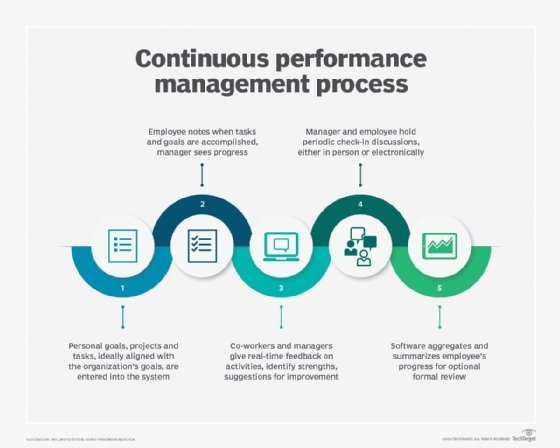What is performance management software?
Performance management software is a tool that enables human resources (HR) teams to measure and track the performance of employees and to implement appropriate programs or strategies to ensure that employee performance is aligned with the organization's business objectives and goals. It helps HR personnel and line managers evaluate how team members are performing and whether they are on track toward achieving specific performance and productivity goals.
Additionally, by using data, performance management software helps managers identify performance gaps in individual employees. Managers can then address the gaps by working with the employee and providing support, mentoring or additional job training.
Performance management software systems are overseen by the HR department. They fit under the umbrella of talent management systems. HR trains managers and employees in the software's use to get the most out of its features for performance measurement, management and improvement.
What does performance management software do?
Performance management software is designed to improve business performance by spurring employee productivity. It works to ensure individual employees and teams are engaged and in alignment with organizational goals.
These systems enable businesses to adjust individual employee goals and expectations as conditions change. Performance management tools provide real-time data that facilitates real-time performance tracking, goal setting and continuous feedback -- something that annual reviews can't do. Annual reviews, according to critics, are too focused on the past and not on forward-looking needs.
Goals of performance management software
Performance management systems are widely considered next-generation workforce management software. These systems help companies to continually monitor employee performance, while giving employees continuous feedback and tailored support.
Performance management software can track individual contributions to a team, as well as that team's ability to meet business objectives. This helps to tie employees' performance to the company's bottom line and identify where there are mismatches that need to be addressed.
Improving employee engagement is another goal of performance management software. An employee can log in to a dashboard to see their individual performance goals and their progress toward meeting them. They can also track their efforts on specific projects, assess their progress and if they need managerial or HR support. Managers set employee goals and can use the tool to measure individual performance against both individual and project goals.
Performance management software ends the tedious -- and often ineffective -- end-of-year annual review process for managers. Instead, they can measure, assess and evaluate employee performance throughout the year. They can also identify problems early and address them before they grow into bigger issues that negatively affect the organization.
Managers and HR teams can use performance management software for the following:
- Set clear goals and objectives for employees.
- Perform frequent check-ins with employees to assess their progress.
- Provide regular and real-time feedback to employees to collectively address problems on priority.
- Provide necessary support to improve employee engagement, retention and profitability.
- Increase transparency in the performance review process through regular communication with employees.
Benefits of performance management software
Performance management software enables managers, HR staff and other stakeholders to measure employee performance in a consistent and tangible manner and can assess how employee performance is impacting the organization's performance. Such assessments are important to determine if employees are performing at the levels expected of them and whether their work is contributing to the company's overall performance and growth.
A data-driven performance management system shows how employees are behaving at work, their strengths and weaknesses, and whether they need additional support to improve their performance. Management can use the insights from the system to institute the required improvements, which can then enhance the performance and productivity of the entire workforce. Additionally, the support provided by the organization can increase employee motivation, improve retention, reduce turnover, and maximize revenue per employee and overall profitability.
Key features of performance management software
At the least, performance management software enables management and employees to set specific, measurable, achievable, relevant and time-bound goals, or SMART goals. These goals provide a tangible and measurable way to set objectives and assess employee performance against those objectives.

Most performance management software incorporates a continuous feedback mechanism for regular and open communication between employees and managers. Managers can assess employee performance, regularly communicate their expectations and set up performance improvement plans. All this can help employees to address gaps immediately instead of having to wait for the end of year review -- by which time, it may be too late to implement the feedback.
Many systems also enable 360-degree feedback, which includes not only input from an employee's supervisor, but also from peers and subordinates. Such a multirater mechanism provides deeper insights into a person's work behaviors and relationships, enabling managers to better evaluate their performance and make better decisions regarding matters like performance improvement, training and promotions.
Performance management systems use dashboards for quick and collaborative reviews, while downloadable reports provide information about individual, project and team performance. Some systems may also include features like review templates, automated reminders and employee ranking.
Effective performance management programs seamlessly interact with other tools, such as workforce analytics. Data can be analyzed, for instance, against reporting from financial management systems and sales performance management systems. Analysis of employee data can be used to make decisions related to hiring, training and development, goal setting and promotions.
Some performance management tools also include features like the following:
- Employee reward and recognition. Managers can analyze and compare employees' performance to determine who should be rewarded and in what way.
- Learning management system. Supervisors and HR personnel can assess employees' current skills and nominate them for skill development and career progression training programs.
- Customizable surveys. Decision-makers can send out surveys to measure employee engagement and gather employee feedback on various aspects related to the company.
- Security features. Reliable performance management tools include security features to safeguard employee data from breaches, such as encryption and access controls. Some tools also back up all data at regular intervals to the cloud to enable fast recovery from data loss incidents.
Future affect of performance management software
AI is expected to have a positive effect on performance management systems. For example, gender or ethnic bias in performance reviews has been identified in multiple studies as a problem for some groups of workers in the workplace. AI-enabled tools could help to remove such biases. Training such tools with diverse data sets that include a wide range of demographic characteristics, including genders and ethnicities, could help to improve the performance of the underlying algorithm, which, in turn, could result in fairer, less biased output.
AI-enabled tools can also be used to detect language patterns that may signal bias. These patterns can help recruiters to make better recruitment decisions. For this reason, such tools are already being used for recruitment management.
Inefficiencies in the performance management process can result in serious consequences, including discrimination or retaliation claims against a company. It is essential for HR personnel to be well versed in these critical issues. Explore key issues in performance management.






